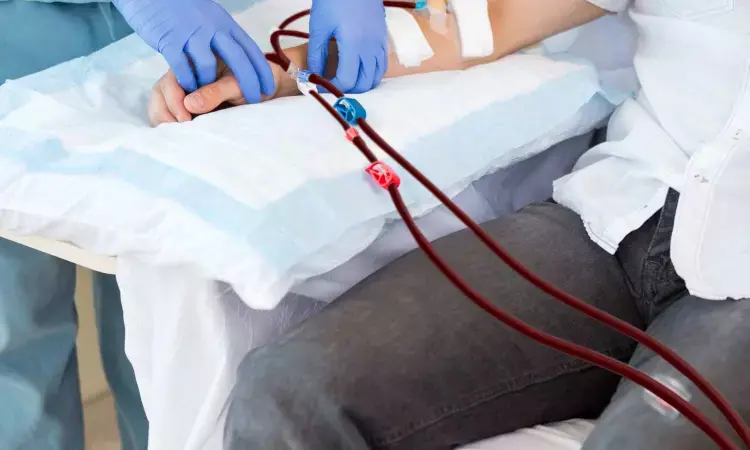- Home
- Medical news & Guidelines
- Anesthesiology
- Cardiology and CTVS
- Critical Care
- Dentistry
- Dermatology
- Diabetes and Endocrinology
- ENT
- Gastroenterology
- Medicine
- Nephrology
- Neurology
- Obstretics-Gynaecology
- Oncology
- Ophthalmology
- Orthopaedics
- Pediatrics-Neonatology
- Psychiatry
- Pulmonology
- Radiology
- Surgery
- Urology
- Laboratory Medicine
- Diet
- Nursing
- Paramedical
- Physiotherapy
- Health news
- Fact Check
- Bone Health Fact Check
- Brain Health Fact Check
- Cancer Related Fact Check
- Child Care Fact Check
- Dental and oral health fact check
- Diabetes and metabolic health fact check
- Diet and Nutrition Fact Check
- Eye and ENT Care Fact Check
- Fitness fact check
- Gut health fact check
- Heart health fact check
- Kidney health fact check
- Medical education fact check
- Men's health fact check
- Respiratory fact check
- Skin and hair care fact check
- Vaccine and Immunization fact check
- Women's health fact check
- AYUSH
- State News
- Andaman and Nicobar Islands
- Andhra Pradesh
- Arunachal Pradesh
- Assam
- Bihar
- Chandigarh
- Chattisgarh
- Dadra and Nagar Haveli
- Daman and Diu
- Delhi
- Goa
- Gujarat
- Haryana
- Himachal Pradesh
- Jammu & Kashmir
- Jharkhand
- Karnataka
- Kerala
- Ladakh
- Lakshadweep
- Madhya Pradesh
- Maharashtra
- Manipur
- Meghalaya
- Mizoram
- Nagaland
- Odisha
- Puducherry
- Punjab
- Rajasthan
- Sikkim
- Tamil Nadu
- Telangana
- Tripura
- Uttar Pradesh
- Uttrakhand
- West Bengal
- Medical Education
- Industry
Study reports substantial increase in incidence of renal replacement therapy due to nephrosclerosis

Japan: A recent study in the journal Nephrology has reported a decrease in incident renal replacement therapy (RRT) due to diabetic nephropathy and chronic glomerulonephritis. In contrast, the incidence rates and the number of RRT due to nephrosclerosis increased from 2006 to 2020.
The Japanese study reveals that the age-standardized incidence rates of end-stage kidney disease (ESKD) requiring renal replacement therapy (RRT) due to chronic glomerulonephritis and diabetic nephropathy have decreased. In contrast, rates due to nephrosclerosis have increased considerably between 2006 and 2020.
Age-specific incidence rates of RRT attributed to nephrosclerosis also increased in many age groups, suggesting that the increased number of patients with nephrosclerosis as a primary kidney disease is not only due to the increasing number of older people but also due to increasing age-specific incidence rates.
The key findings include the following:
• Age-standardized incidence rates of RRT due to diabetic nephropathy significantly declined in both sexes, although not as steeply as the decline seen for chronic glomerulonephritis.
• The incidence rate of patients requiring RRT due to nephrosclerosis increased by 132% for men and 62% for women from 2006 to 2020, and the age-standardized incidence rate of RRT due to nephrosclerosis also increased considerably during this period in both sexes.
• Age-specific incidence rates of RRT attributed to nephrosclerosis also increased in many age groups from 2006 to 2020, suggesting that the increase in the number of patients with nephrosclerosis is not only due to increasing numbers of older people, but also, because of increasing age-specific incidence rates.
"We urgently need effective strategies to reduce the burden of ESKD requiring RRT in order to mitigate its expected financial and health burdens, because the number of patients with ESKD is projected to increase in the near future," said Dr. Wakasugi, the corresponding author of the study. "Understanding recent trends in RRT incidence by disease type will help establish strategies to lower these rates in the general population."
Using data from the Japanese Society of Dialysis Therapy registry and national census, the study revealed that age-standardized incidence rates of RRT due to nephrosclerosis increased significantly by 3.3% (95% confidence interval (CI): 2.9 to 3.7) and 1.4% (95% CI: 0.8 to 1.9) per year for men and women, respectively. The average annual percentage change of chronic glomerulonephritis at -4.4% (95% CI: -5.3 to -3.8) for men and -5.1% (95% CI: -5.5 to -4.6) for women) and diabetic nephropathy at -0.6% (95% CI: -0.9 to -0.3) for men and -2.8% (95% CI: -3.1 to -2.6) for women significantly decreased from 2006 to 2020.
"Our finding that age-standardized incidence rates of RRT due to diabetic nephropathy significantly declined is encouraging because a previous study reported that the age-adjusted rate for diabetic nephropathy increased rapidly from 1983 to 2000. While our data cannot provide a definitive reason for the decreased incidence rates of RRT due to diabetic nephropathy, two factors-a stabilized the trend in type 2 diabetes prevalence in the general population, and recent developments in strategies to reduce the progression of diabetic nephropathy may have contributed," said Dr. Wakasugi. "The second important finding of our study is that the number and population incidence rate of new RRT cases due to nephrosclerosis have increased considerably during the study period. We urgently need effective strategies to reduce the burden of nephrosclerosis."
Reference:
Minako Wakasugi, Ichiei Narita First published: 03 December 2022 https://doi.org/10.1111/nep.14134
Dr Kamal Kant Kohli-MBBS, DTCD- a chest specialist with more than 30 years of practice and a flair for writing clinical articles, Dr Kamal Kant Kohli joined Medical Dialogues as a Chief Editor of Medical News. Besides writing articles, as an editor, he proofreads and verifies all the medical content published on Medical Dialogues including those coming from journals, studies,medical conferences,guidelines etc. Email: drkohli@medicaldialogues.in. Contact no. 011-43720751


